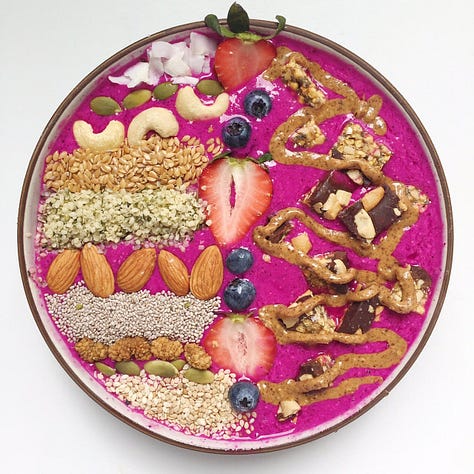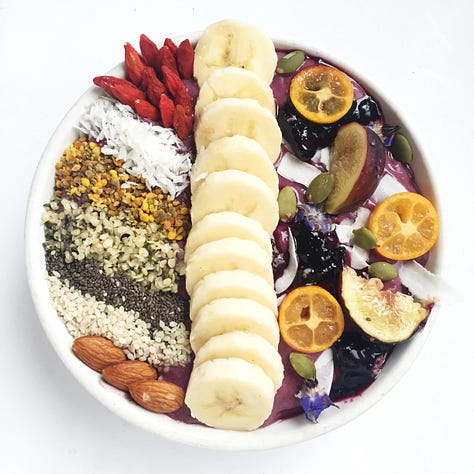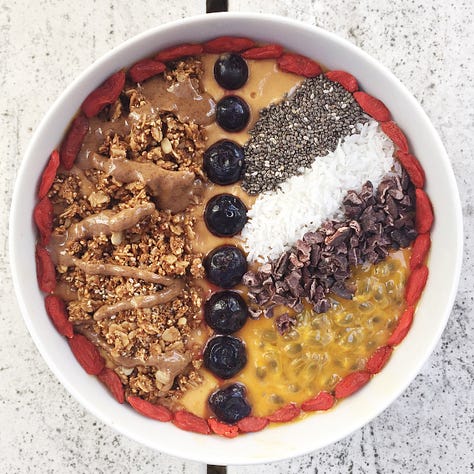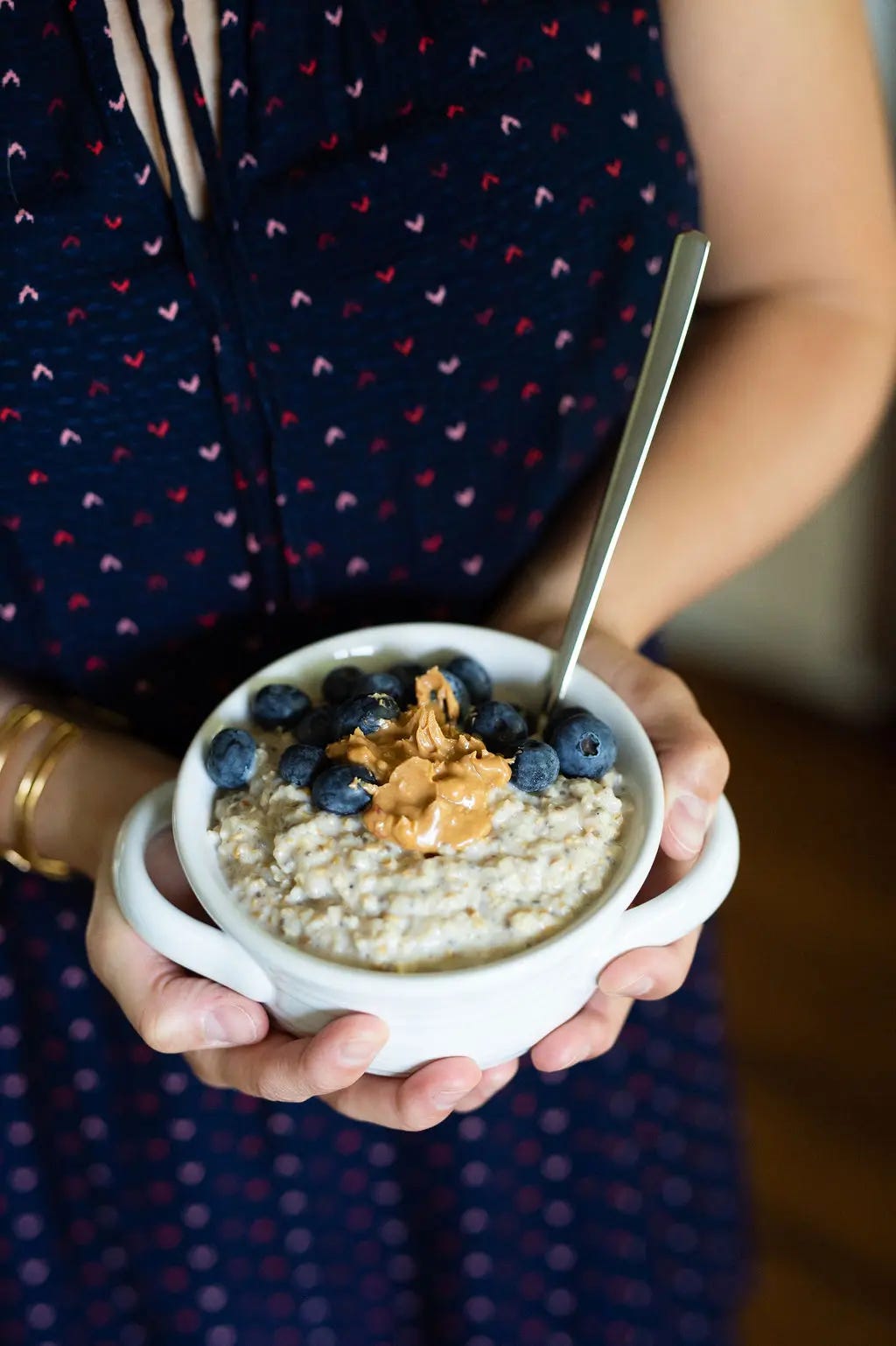Vegan.
Pescatarian.
Paleo.
Low FODMAP.
Ayurvedic.
Meal prepping.
Health at every size.
Over the years, I’ve experimented with all different eating styles and regimens, often mixing several together at one point or another.
This journey with food and a hyper-focus on eating began when I started dieting at the age of 16, which inevitably led to anorexia, which it often does, as 20-25% of diets turn into a life-long eating disorder1.
Later, I became a successful food blogger and internet personality focused on food and wellness. By age 29, I found myself in recovery again— but this time from a rigid view of wellness culture and orthorexia-related restrictive habits.
With everything I’ve gone through, I thought it would be helpful to share how I view food and eating now. My philosophy has evolved significantly since 2019, and perhaps you’ll see some of your own experiences reflected in it.
How I Used to View Food
But first.. if you’re new here, and you don’t know me, I used to be a wellness influencer under the name @leefromamerica. My focus was on food, lifestyle, and recipes. My fat balls were one of the first recipes to take off, a recipe I developed as I aimed to consume mostly fat instead of sugar.
But my smoothie bowls are what put me on the map.
They catapulted me into viral fame. I made them in all types of flavors, styles, with jewel-colored bases and a pantry’s worth of toppings, intricately lined up for ultimate IG-eye-orgasms.
Once I became sugar-averse, I became known for throwing things like steamed frozen cauliflower or avocados into my smoothies in place of bananas to thicken them up without the sugar. This was all to heal my P.C.O.S., or Poly Cycstic Ovarian Syndrome.






But even before I was a full-time wellness influencer, getting paid tens of thousands to shill collagen, matcha powder, and natural birth control to my followers, I was just a college-aged girl living on the budding inter webs.
Like Gen-Zers of today (and most millennials, too), I turned to the internet to tell me how to eat. The Journal of Medical Internet Research found that 75% of young adults (ages 18-24) prefer to use the internet to seek health information before consulting with a healthcare professional. I was one of those people.
As a freshman in college in 2008, just four months out of eating disorder treatment, I was thrust into a dorm room with hundreds of other young people who were interested in beer and frat parties. I’d almost life my life and independence, so I wasn’t super interested in chugging Bacardi and kissing freshman boys like most of the other freshman girls.
So I turned to the internet. I sought solace in Kath Eats Real Food (KERF), a blogger introduced me to the concept of oatmeal porn.
KERF was infamous for that little irresistible dollop of peanut butter in her oatmeal, often meticulously measured out—she was a dietitian, after all. A runner and natural beer lover, she and her husband were wholesome; they spent Saturdays at farmer’s markets and meeting up for wine spritzers with friends. She documented every morsel that touched her lips and shared non-food-related bits like thrift store finds and their travels to various resorts in the Bahamas. Her writing had a little Southern twang that I found genuine and calming. I grew to love her.
She was the first person I saw write about food in a balanced way—making the process of thinking about, writing, and photographing food seem normal and even appealing. She would go on to be a huge source of inspiration behind starting Lee From America.
And then, in 2012, I looked to Free Lee the Banana Girl, Loni Jane, and Raw Kristina, the latter of which insists that eating raw foods changed her eye color from brown to green, the former of which stated (in a now deleted YouTube video) that September 11th unjustly killed fit people who got stuck in the stairwells behind fat people.
Yeah, I was getting diet advice from people like her.
Most of them lived in the Southern Hemisphere, while I spent many winter Saturdays in my West Village apartment, nursing a Molly hangover after nights at Verboten or Output. I would longingly browse their feeds, filled with impossibly tanned and toned bodies, papaya-watermelon lunches (#monomeals), and boundless energy for their daily activities—something I lacked while battling addiction and enduring an unhappy relationship.
Then, I moved to LA, where everyone and their naturopaths had their own set of beliefs on what a healthy diet was. I turned to roommates, people in my yoga class, other bloggers, and Pinterest trends to tell me how to eat.
And then, when I became a full-time influencer, and it was my job to be *the healthiest girl on the internet*, I followed what my followers told me to do. Simple comments like “have you tried intermittent fasting?”
“have you tried chia pudding?”
or,
“You must try the FODMAP diet!! i am a specialist!”
caused me to adapt their recommendation.
It seemed like the only person I wasn’t listening to was myself.
In 2019, nearly a full decade after my initial stint in rehab for my eating disorder, I sought help for orthorexia at a recovery center in Los Angeles. My rigid approach to food and lifestyle had pushed me to a breaking point.
I embraced the “all foods fit” ideology with guidance from trained professionals at rehab. After 7 years recipe developing for my website and blog, I’d lost inspiration and was in dire need of a break from cooking. While my passion for cooking waned, my love for food itself remained; it just needed to get “right-sized” and stop taking up such a huge part of my headspace. It wasn’t until about two years ago that I rediscovered my joy for cooking.
But wait,
What is orthorexia?
Web MD signifies the signs and symptoms of orthorexia as follows:
A fixation over the quality of food
Inflexible eating patterns
Severe emotional turmoil if “rules” are broken
Cutting out entire food groups
Constant worry about sickness or disease
Anxiety from being around certain foods
While a food blogger, I convinced myself to eat gluten-free, soy-free, dairy-free, and sugar-free. I was constantly bloated and experiencing digestive issues (another signifier of eating disorders).
I was trying every diet under the sun, and none of it healed my God-sized hole. And it’s still the same: every few months, a new TikTok diet ‘emerges’, but it’s the same stuff recycled for a new generation who thinks they started it.
So without further ado, a list of all the philosophies and inspirations behind how I eat today, taking in my 34 years of experience and kind of obscure career path. It’s for paid subscribers only, which is $5/month or $50/year.







